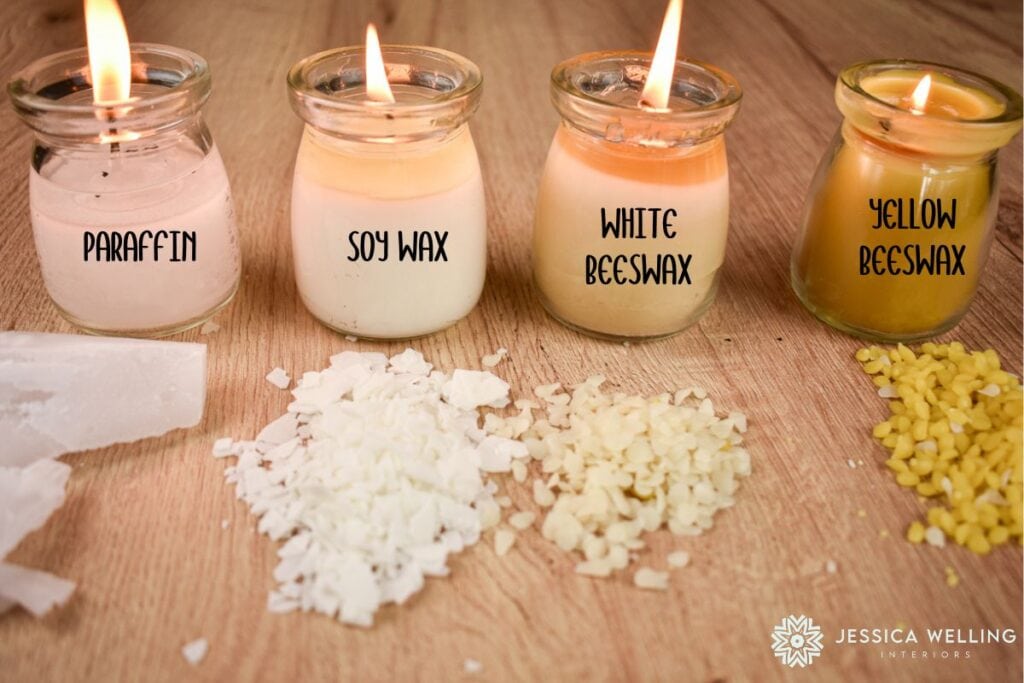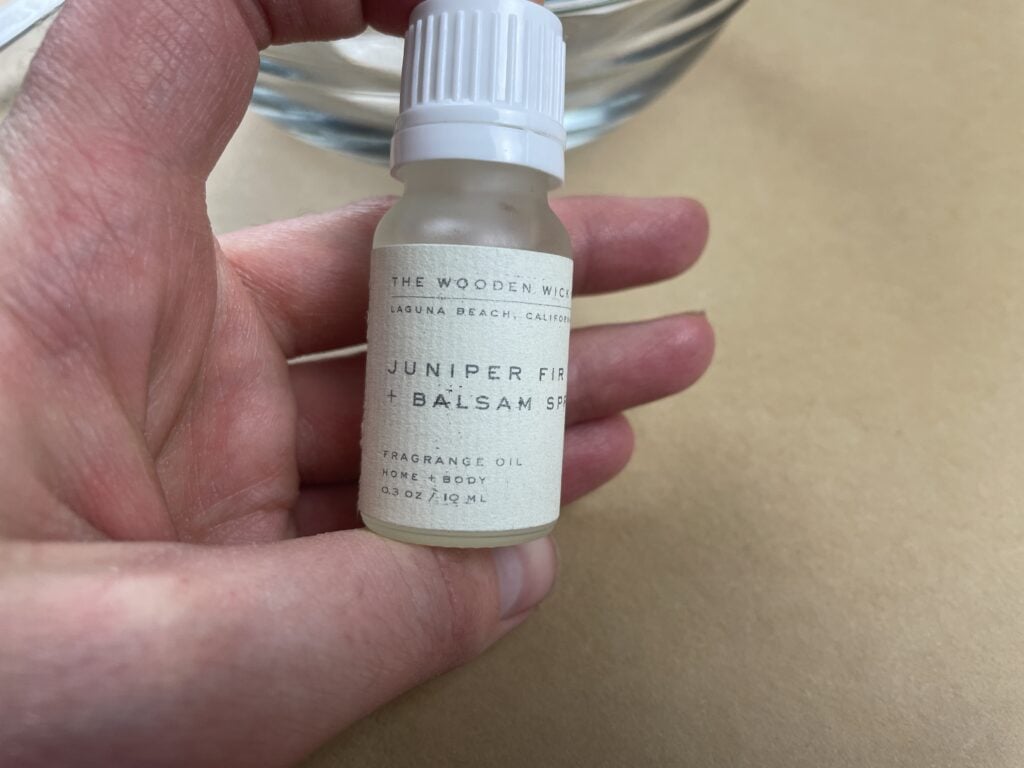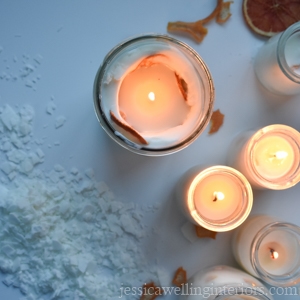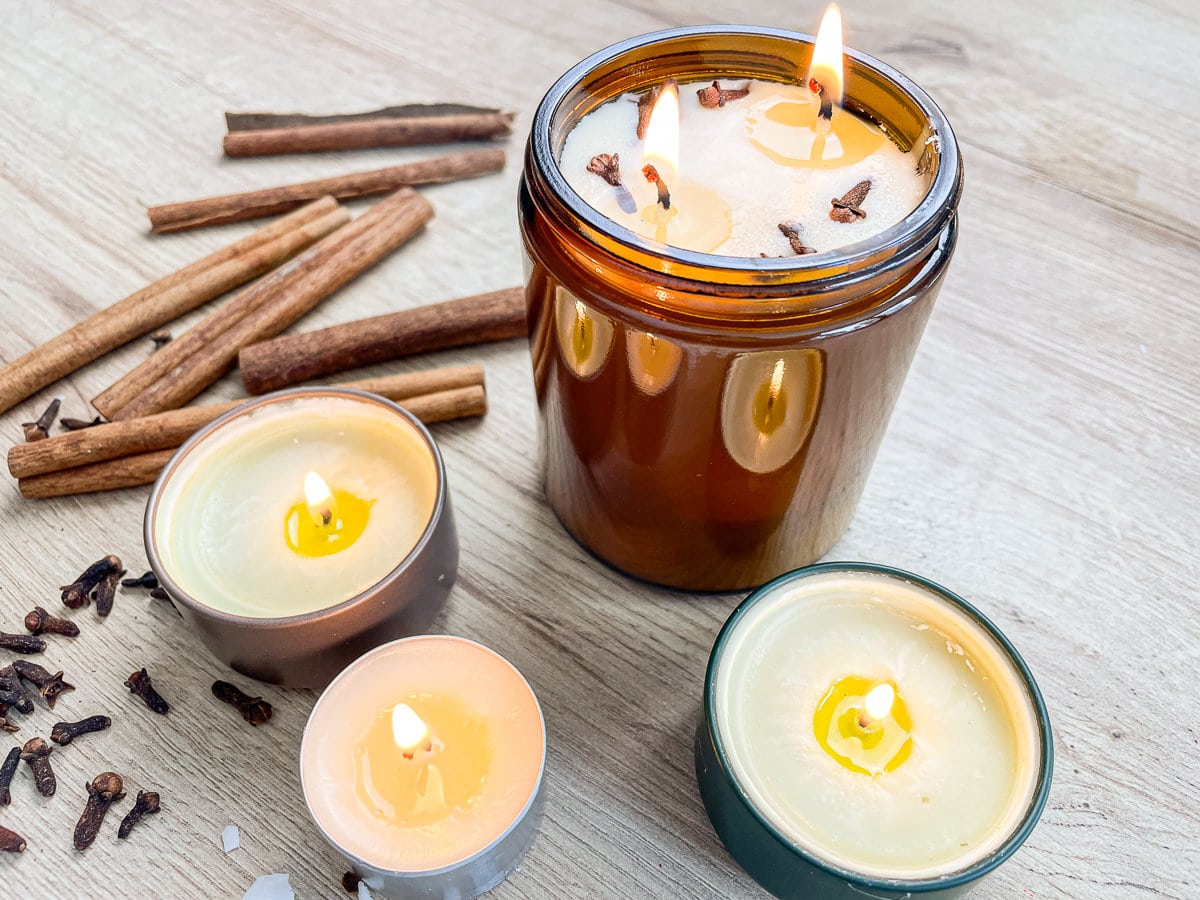How to Make Candles: A Beginner’s Guide
Learn how to make candles with this complete guide. From wax to wicks, to containers and the best fragrance oils, I’ve got you covered.

How to Make Candles: Quick-Start Guide
If you’re eager to get started and want to jump right to a great beginner candle-making tutorial, without delving into the pros and cons of different candle waxes, wick types, ideal pour temperatures, etc., this easy DIY soy candle guide is a great place to start:
How to Make Soy Candles: A Beginner’s Guide
Or if you prefer to make paraffin candles, this step-by-step tutorial will get you started. More on the different types of wax below.
DIY Candle Recipes
And here are a few of my favorite candle projects:
Paraffin vs. Soy Wax
There are several varieties of candle wax available, and each one has it’s pros and cons. The most common type is paraffin wax. It’s inexpensive, easy to work with, and has the best performance of all the wax varieties in terms of scent throw.
Here’s a simple paraffin candle tutorial. The recipe and instructions are essentially the same as my soy candle recipe.
What Type of Wax Is Best for DIY Scented Candles?

Most store-bought candles are made from paraffin. But it’s a petroleum product and releases carcinogens into the air when it’s burned, specifically benzene and toluene. Many people are concerned about the health implications of burning paraffin candles indoors.

Personally, I usually reserve paraffin wax for candles I plan to burn outdoors, like these DIY citronella candles. It’s also the best option if you want to make pillar candles, since it is much harder than other natural waxes in it’s solid state.
Soy Wax
Natural soy wax has gained popularity in recent years because it is relatively inexpensive and easy to work with. It has a decent scent throw, but it’s important to use high quality fragrance oils with it.
Soy wax works best in container candles, because it is relatively soft at room temperature, and may not hold it’s shape well in a pillar candle.
It usually comes in flakes like this:

What’s the Best Soy Wax for Candle Making?
This is my favorite brand of natural soy wax from Amazon. I also like that this wax comes with cotton wicks and wick holders. I also like this Supernatural Soy Wax from Makesy.
One more note about soy wax. It cleans up with just soap and water, and you can put the containers and utensils you use right in the dishwasher! And believe me, this is a HUGE advantage when clean-up time comes around! Never underestimate the power of easy clean-up.
Beeswax

Beeswax makes lovely scented candles, but it’s by far the most difficult wax to work with. If you’re brand new to candle making, it’s not the type of wax I would recommend. But if you want to go for it, here’s my go-to beeswax candle recipe.
For a more in-depth comparison of the different types of candle wax, check out this article:
What is the Best Wax for Candles? Soy vs. Beeswax vs. Paraffin
Candle Fragrance Oils
There are a couple of basic terms you’ll want to understand before we discuss fragrance oils for scented candles.
Cold Throw
The amount of fragrance a candle gives off when unlit. This is especially important if you’re making candles to sell, since the first thing customers will do is remove the lid and smell the candle! People will do the same thing when you give candles as gifts. First impressions are important!
Hot Throw
The amount of fragrance a candle releases while burning. I don’t think I need to explain why this is important.
Fragrance Load
The amount of fragrance oil a specific variety of candle wax can hold. You’ll see this expressed as a percentage. Most waxes have a fragrance load around 10%, and that’s the ratio I use in all my candle recipes.

I’ve tried A LOT of different candle fragrance oils. And my main take-away is that they are NOT all created equal. I started with the cheapest oils I could find on Etsy.
Do you remember those little pots of wood chip potpourri in every ladies’ restroom in the 90’s? Yeah. Every fragrance I tried my first go ’round smelled like that. Ick!
But I was determined, and after testing over 80 different fragrance oils from 7 different companies, I have a list of winners. And almost all of them are from Makesy (formerly The Wooden Wick Company), with a few others thrown in for good measure.
Here’s my list of my favorite fragrance oils for candles and where to get them.

If you’re not sure which fragrances you like, I recommend getting one of their discovery kits (above). I’m especially enjoying the Citrus and Herb and All Natural kits.
Each kit includes 10 different sample-sized scents. One bottle will make a couple of small candles or a batch of wax melts.

Can You Use Essential Oils To Make Scented Candles?
The short answer is, “not very well.” Sorry, I know that’s probably not what you wanted to hear. But bear with me because I’m going to save you some heartache and potentially a lot of money. And I have a great alternative.
When I first began making my own scented candles, I was excited to try using essential oils in place of traditional candle fragrance oils. It seemed like the obvious way to make all-natural candles.
But…the results were disappointing, and I ended up wasting A LOT of expensive essential oils in the process. The candles hardly had any scent at all!
Here’s the problem: When you’re making DIY scented candles, the goal is generally to achieve a strong “cold throw” (the amount of scent released when the candle is not burning) and “hot throw” (the amount of fragrance released when you burn your candle).
The fragrance oils need to be added to the hot wax, generally somewhere between 175-185 degrees Fahrenheit in order for the two to bind together properly.
Essential oils break down when they’re heated, so their power is significantly diminished from the moment you add them to the wax. And then more so every time you burn your candle.

Bottom line, it’s just not an effective way to make scented candles or to use essential oils. If you want to use essential oils to scent your home, I recommend using a diffuser instead.
What Fragrance Oils Can I Use To Make Natural Scented Candles?
Most fragrance oils on the market are made from synthetic chemicals. But there are some natural candle fragrance oils made entirely from plants. The best ones I’ve found are from Makesy (formerly The Wooden Wick Co.).

I have a sensitive nose, and don’t really like artificial fragrances very much. So I was thrilled to find these natural fragrance oils that smell natural too.
Candle Wax Dye

Candle wax dye comes in a few different forms. You can get blocks (these often come in a candy bar shape like the ones below), chips (which are the blocks mentioned before shaved into little bits), or liquid wax dye.

Any of these will work just fine to color your candles. It’s mostly a matter of personal preference.
I like to use wax dye chips because it’s easy to control the amount of color you’re adding. This is the kit I use (below), and it’s lasted me over a year (and I make A LOT of candles and wax melts!).

I also like that the containers are easy to open and reseal, unlike kits that come with a bunch of mini zip-top bags.


The one problem that often comes up with wax dye is the dye chips not melting all the way, leaving little specks in your wax.
The solution is to heat the wax up a bit more to ensure everything melts. Just be sure you get the wax back down to the 175-185 degrees Fahrenheit range again before adding the fragrance oils.
Candle Vessels
You can use any container that’s heat-resistant and non-flammable to make candles, so metal, glass, and ceramic are the most common materials. Here’s a list of my favorite candle jars & tins.
It’s helpful if your container of choice comes with a lid to keep the candle sealed up while not in use. A few I’ve tried have also come with labels, which is great if you’re planning to sell your candles or give them as gifts.
Here are a few of my favorite candle containers from Amazon that I’ve tried:

A. Mini Glass Jars with Cork Lids (30-Pack)
B. Colorful Boho Candle Tins with Lids (36-Pack)
C. DIY Candle Tins Multi-Pack (24-Pack)
D. Zenjevie 8 oz. Candle Tins in Gold (12-Pack)
E. 8 Oz. Mason Jars with Lids & Chalkboard Labels (12 Pack)
Guide To Wicks



Securing the Wicks
There are a couple of different methods for attaching the wick to the bottom of your candle container before pouring the wax, and then many more ways to hold the wick upright while you pour the candle and let it cool.



Cotton wicks generally come pre-waxed, so they’re fairly stiff. You may be able to get the wick to stand up straight inside the container on its own. But as soon as you pour hot wax around it, it will get floppy.
That’s why you need a wick holder. You’ll also see this referred to as a “wick centering device”. I like to use the metal wick holders in the photos above are perfect for this, and they even have multiple holes if you need to use more than one wick.

They come with the soy wax I buy from Amazon (along with a whole bunch of cotton wicks).

You can also get these inexpensive wood wick holders (above). They’re basically a popsicle stick with a hole in the center, but I haven’t had great success with them. Since they’re very lightweight, they tend to move around.

Wax Melts
You may end up with some leftover scented wax after pouring your candles. This is the perfect opportunity to try making wax melts!
Any kind of wax will work. You just pour your leftover scented wax into a silicone wax mold- this is a list of my favorite inexpensive wax molds from Amazon. Then let it cool and pop the melts out of the mold.

Getting The Most Out Of Your DIY Candles
The first time you light your candle, be sure to burn it long enough for the wax pool to completely fill the top of the container. This may take a few hours, depending on the size if the candle and the number and size of the wicks you use.

If you don’t do this, you’ll get an effect called “tunneling,” where you end up burning a hole down the center of your candle, without using most of the wax. I’m sure you’ve seen this before. It wastes a lot of the wax and is generally not desirable with container candles.
More DIY Candles and Wax Melts…
How to Make Wax Melts: Everything You Need to Know
The Best Fragrance Oils for Candles (That Actually Smell Good!)



















Love, love, love your blog. I learned so much and I’m so grateful for the links. Thank you
Love, love, love your blog. I learned so much and I’m so grateful for the links also. My favorite candle company went out of business and I have not found one that has the strong scent that I appreciate. So I have decided to DIY. Thank you
Thank you so much! I hope you enjoy candle making!
Greetings Jessica! I found your knowledge to be just what I need. I haven’t had too much luck finding suitable tins and fragrance oil. Perhaps you could help me. Kindest regards, Susan
Hi Susan, thanks for reaching out! Here’s a post about my favorite fragrance oils: https://jessicawellinginteriors.com/best-fragrance-oils-for-candles/ and here’s one about jars & tins of every size: https://jessicawellinginteriors.com/candle-jars-and-tins/ Hope this helps!